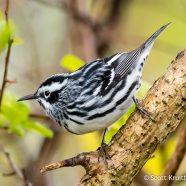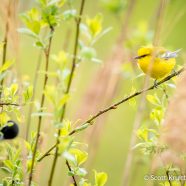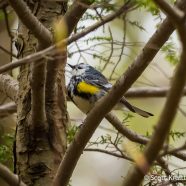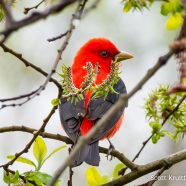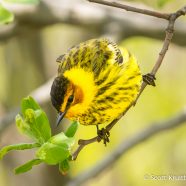Black-and-white Warbler
I finally took some good photos of Black-and-white Warblers (Mniotilta varia) over the last few days as the species is peaking as a migrant in the Northeast. These stunning little birds never stop moving…and they move like a nuthatch, creeping and crawling along branches, vines and tree trunks for various insects and spiders. This nonstop motion makes them a difficult clean capture as their photos often end up a little blurry. At least this guy – while still not paying me any attention – paused for a moment or two while searching for prey on Sunday morning. I found an even...
Read MoreBlue-winged Warbler
This is another photo that I captured yesterday morning with a semi-friendly Blue-winged Warbler (Vermivora cyanoptera) taking a glance at me before he moved on. Can you identify the bird in the background? I intentionally did not crop this photo very much because I liked seeing the adult male Orchard Oriole (Icterus spurius) chowing down not much further up the trail from the warbler. I saw plenty of both Orchard and Baltimore Orioles yesterday, but none of them were very friendly for the camera. I’ll get you, orioles… Scott Kruitbosch Conservation & Outreach...
Read MoreLeucistic Yellow-rumped Warbler
Here is that unique Yellow-rumped Warbler which I mentioned in a previous post. Can you see what looks different about it? I noticed it naked eye while tracking various subjects in a loose flock through the trees last week including more Yellow-rumps, Black-and-white Warblers, Blue-headed Vireos, and Blue-gray Gnatcatchers. After I got my binoculars on it I realized this bird was partially leucistic, and I quickly raised my camera to snap off a record photo. Leucism in birds is when melanin pigments are produced at less than normal levels or in an unexpected pattern. In this case many of the...
Read MoreScarlet Tanager
Even the branches of this willow could not block the glow from the fiery feathers of a male Scarlet Tanager (Piranga olivacea). I photographed this bird yesterday as it was staying near eye-level, though it was wary of me and preferred to remain “hidden” like this from afar. These canopy dwellers are so vibrant that even the sharpest lens perfectly locked on and focused always make them look just slightly blurry. They are a flame in the forest. Scott Kruitbosch Conservation & Outreach Coordinator
Read MoreCape May Warblers
Today I had the best views of Cape May Warblers ever during easily the best day of spring migration so far this year. Birds that had been trapped in the Mid-Atlantic for a week or 10 days finally moved north with heavy migration occurring on southerly winds. New England and northern New York had poor migratory conditions still, stopping a lot of birds when they arrived, and some areas of fog and/or rain also helped locally. I thought these couple of shots were the best I would get, and I was happy enough… But they decided to stick around after the clouds cleared and show off, feeding...
Read More



